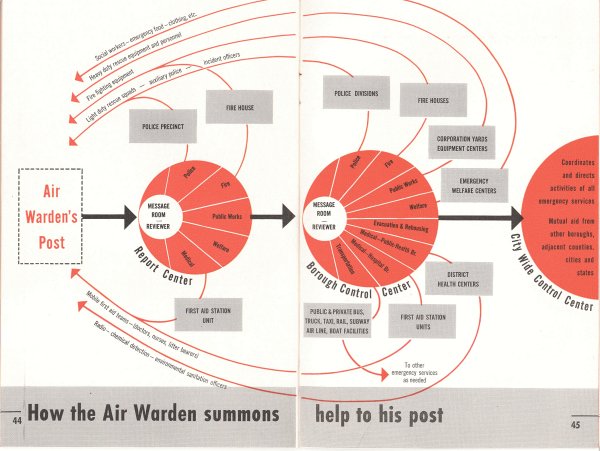Handbook for Air Wardens, Part Two
Office of Civil Defense
City of New York
Police Emergency Division
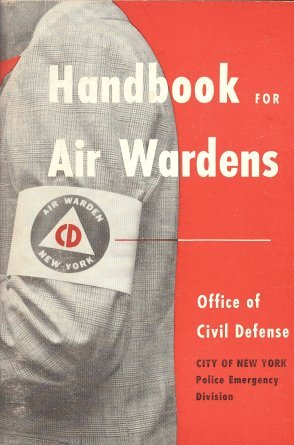
CITYWIDE ORGANIZATION
T0 PREVENT OVERLAPPING and duplication, of effort in an emergency, you must know not only the duties of the Air Warden Service but the place it occupies in the entire Civil Defense Organization of the City of New York. Familiarity with the over-aU operation will give you the assurance that there are many agencies from which your post can expect help in the event of an attack, show you what their duties are and teU you how you can best assist them to do their jobs.
The Civil Defense Organization of New York City is a huge team, ultimately 1,000,000 strong, built on a framework of the existing departments of your city government. It consists of seven basic emergency divisions. (See chart, pages 10-1l.) These divisions and their assignments are as follows:
Transportation Division
TRANSPORTS personnel and equipment to and from threatened or damaged areas . . . carries supplies and personnel within damaged areas . . . furnishes transportation to other Civil Defense emergency services upon request . . . repairs damage to transportation facilities and equipment. . . develops transport schedules for evacuation.
Police Emergency Division
RESPONSIBLE for first line security measures and preservation of law and order, including patrol, traffic control, bomb reconnaissance, fire watching, light duty rescue, building control, management of report centers, air raid warning transmission, operation of a messenger service, furnishing supplementary transportation. It consists of three principal groups, the Uni· formed Force, the Air Warden Service, and the Auxiliary Police. For a detailed description of this division, of which you are a part, see pages 12-22.
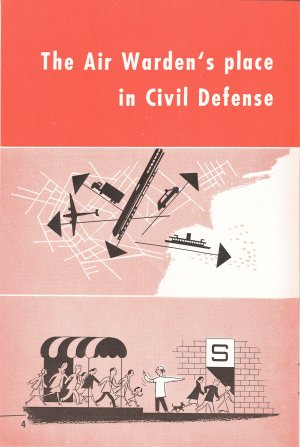
Fire Emergency Division
PREVENTS and fights fires resulting from enemy attack cooperates with other agencies in removing casualties.
Public Works Emergency Division
CLEARS streets of debris in order to make way for emergency vehicles . . . makes emergency repairs . . . does heavy rescue work . . . designs and builds public shelters.
Welfare Emergency Division
MAINTAINS mass feeding stations, mass shelters, welfare and rest centers . . . operates a Central Registration Bureau through which all persons affected by enemy attack may be located.
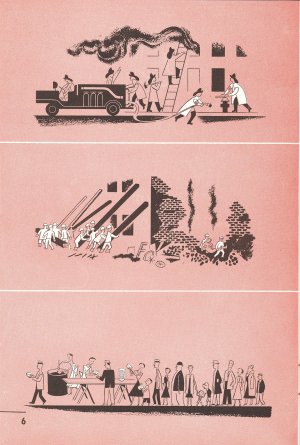
Medical Emergency Division
CONSISTS of Hospital Branch and Public Health Branch. Hospital Branch cares for casualties. . . operates casualty stations, first aid posts, blood banks, auxiliary ambulance corps, emergency field units, medical and stretcher teams, mortuary ~. service . . . evacuates casualties and hospital patients. Public Health Branch sets up and mans casualty aid stations . . . responsible for sanitation, public hygiene and distribution of public health information. . . detects and decontaminates radioactive materials . . . responsible for chemical and bacteriological detection.
Division of Control and Report Centers
RESPONSIBLE for adequate Air Raid Signal System . . . assures that all Civil Defense divisions have adequate communication systems. . . works with commercial broadcasting and television stations and amateur radio operators . . . sets up communications for City Control Center and Borough Control Centers. The communications companies, such as the New York Telephone Company, Western Union and the broadcasting networks, participate in this program. Volunteers for Report Centers are recruited and trained by the Police Emergency Division.
Evacuation and Re-Housing Division (not an emergency division)
PLANS re-location of civilians from damaged to undamaged areas . . . arranges for their housing.
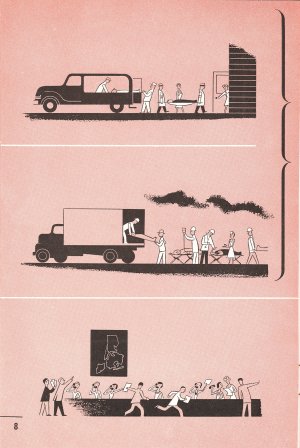
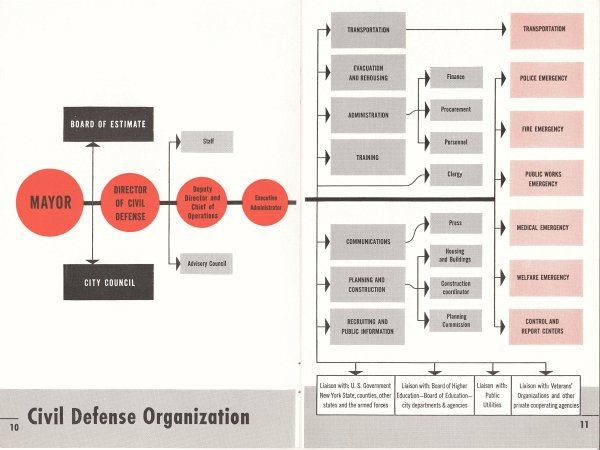
POLICE EMERGENCY DIVISION
THE POLICE COMMISSIONER is Director of the Police Emergency Division of the Civil Defense Organization. He has established a Division of Civil Defense which is the central coordinating agency for the various civil defense operations for which the Police Emergency Division is responsible.
The chain of command runs from Police Headquarters through the Police Department's patrol divisions, down to the patrol precincts, Traffic Precinct N which covers Randall's and Ward's Islands, and the Harbor Precinct, which covers the other islands and the waters in the jurisdiction of New York City.
Police officers are assigned as Division and Precinct Civil Defense Coordinators. Their job is to supervise and integrate the activities of the members of the Police Emergency Division. The Air Warden Service, of which you are a key worker, is one of the three principal branches of this division.
How the Air Warden Service operates
THE CHART on pages 16-20 shows you the organization of the Aid Warden Service. Note that the Commandant of this service has on his staff seven acting captains, who are heads of the various bureaus of the Air Warden Service. Civilians who are citywide directors and borough directors form the staff of each acting captain. The Police Department Divisions and Precincts have similar staff organizations.
These staff officers make policies and plan operations, but put these plans and policies into effect through the responsible Civil Defense Coordinators at the various levels. As the chart indicates, you take your orders from your Squad Leader, who in turn, is responsible, through his Sector and Zone Commanders, to the Precinct Civil Defense Coordinator.
The Air Warden Service consists of the Zone, Sector and Post Warden Organization and various specialized groups, which function as follows:
Zone, Sector and Post Warden Organization
NEW YORK CITY'S patrol precincts, Traffic N and the Harbor Precinct serve as the administrative units for the Air Warden Service. The territory within each of these precincts has been divided into zones, sectors and posts.
A zone embraces an area in which approximately 50,000 persons live. It is supervised by a Zone Commander and five Deputies. A sector is an area with a population of 5,000 persons. It is supervised by a Sector Commander and five Deputies.
The population of a post is approximately 500 persons. The post's organization consists of a Squad Leader, three Deputy Squad Leaders and at least eight Air Wardens. Two of the wardens are designated as fire watchers and two as telephone wardens.
As a headquarters and meeting place for his squad, each squad leader selects a Post Control Point, which must be approved by the Precinct Civil Defense Coordinator. This Post Control Point should be as near as possible to the post's specially designated telephone, which will be a telephone accessible twenty-four hours a day.
The fire watchers' assignments are to set up an informational relay system from the roof of the highest building on the post, to spot and report fires after an attack and to control small fires which they can reach. The principal function of the fire watcher is to keep to a minimum the number of fires to which the Fire Department will have to respond.
Precincts and zones are designated by numbers, sectors by letters, and posts by numbers. Thus if you are a warden of Post 4 in Sector M, Zone 1 of the 21st Precinct, the complete designation of the assignment is 21-1-M-4. You must memorize the complete designation of your assignment, as well as your individual identification number, which was issued to you when you enrolled.
Light Duty Rescue Service
ONE LIGHT DUTY RESCUE SQUAD, consisting of one or more teams of ten men each, will be assigned to each zone. Members of these teams are physically qualified men with experience in building and similar trades. Their job is to rescue persons trapped in damaged buildings, and to shut off household utilities to prevent secondary fires.
Messenger Service
MEMBERS of this service provide the vital lines of communication in the event that the mechanical systems are disrupted as the result of an enemy attack. Messengers work at all levels of the Air Warden Service, including Headquarters, Division Report Centers, Precinct Station Houses, Zone and Sector Headquarters, and Warden Posts.
Emergency Taxi Corps
THIS CORPS will consist of the city's entire fleet of n,791 taxicabs and its 33,848 taxi drivers. Its job is to provide emergency transportation for personnel and equipment to trouble spots and to handle other transportation and communications assignments. In an emergency it will operate as a unit of the Transportation Division.
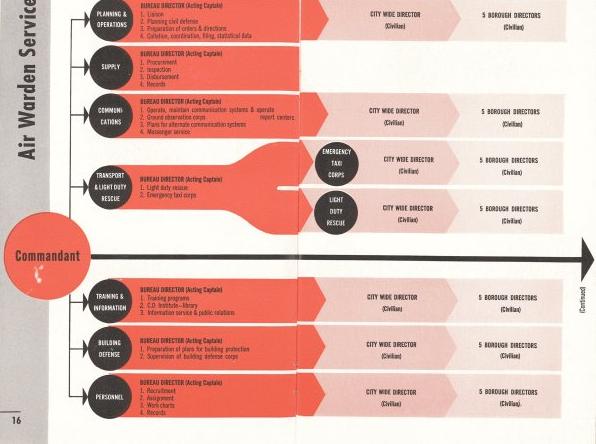
Bureau of Building Defense
THE MISSION of this group is to organize internal defense units in all buildings of the city with the exception of I-family and 2-family dwellings.
The Building Control Director may be the building superintendent, or the manager, or he may be a tenant. Working in close cooperation with the Air Wardens on his post, he will appoint tenants and building employees as deputy director, floor wardens, and deputy floor wardens, fire watchers and first aid workers.
The Building Control Director must set up an inter-communication system within the building to notify its occupants of an emergency, plan the orderly movement of occupants to shelters, provide for manual control of mechanical services such as master electric switches and utility shut-off valves, and determine the best locations in the building for emergency shelters and First Aid Stations.
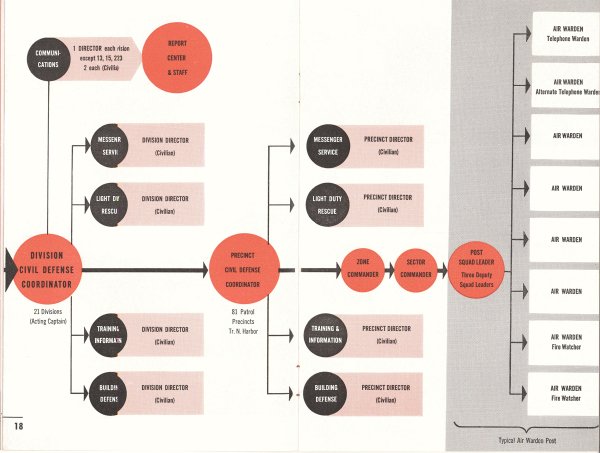
Directors of Training and Information
UNDER THE DIRECTION of their unit Civil Defense Coordinator, this group, on all levels, is responsible for the effective training of civilian personnel in their respective branches of the Air Warden Service. The principal functions of the Directors of Training and Information are to lecture, obtain lecturers and instructors, arrange for appropriate locations for classes, obtain training materials and supervise schedules and procedures.
